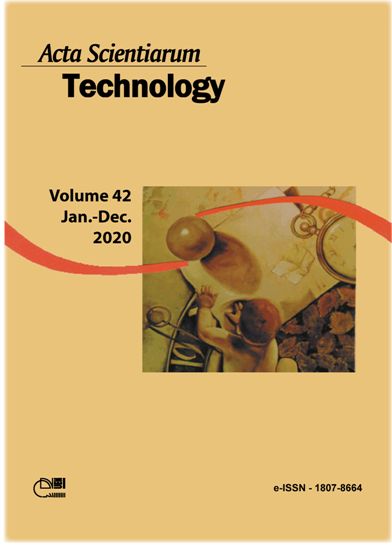Ultrasound affects the selectivity and activity of immobilized lipases applied to fatty acid ethyl ester synthesis
DOI:
https://doi.org/10.4025/actascitechnol.v42i1.46582Palavras-chave:
ultrasound; biodiesel synthesis; immobilized lipases; hydrophobic immobilization; enzyme selectivity.Resumo
Hydrophobic carriers can be used to improve the activity, stability and other properties of enzymes. Physical agents, like ultrasound, may also contribute to improving the dispersion and collision of the reagent molecules, decreasing the reaction time and intensifying the catalytic process. However, its effect on the enzyme activity and reaction selectivity is still not entirely understood. Here, enzyme modulation of immobilized lipases was studied under pulsed ultrasound irradiation in fatty acid ethyl ester (FAEE) synthesis for biodiesel production. Novozym 435® and two commercial lipases from Thermomyces lanuginosus and Rhizomucor miehei, immobilized on Octadecyl-Sepabeads were used as a biocatalyst in the transesterification reaction of vegetable oils and ethanol. The use of ultrasound associated with catalysis by the Novozym 435 increased the production of FAEE by about three times (from 8.9 to 26.4%) using soybean oil and changes were observed in the profile of the products. From the sonicated reaction, ethyl-palmitate production decreased from 23.4 to 11.7%, while the ethyl-linoleate content rose from 47.5 to 59.2%. On the other hand, the T. lanuginosus lipase was less affected by sonication with the overall production of FAEE increasing from 17.2 to 24.1%, with ethyl-palmitate and ethyl-linoleate content changing from 16.2 to 17.5% and 55.0 to 47.8%, respectively. Although the changes in the production yield are not too high, the main idea here was to show that ultrasound modulates the lipase activity as well as its respective selectivity. Thus, ultrasound, is responsible for changing the ethyl ester production, which can be applied to many other biochemical processes to improve or modulate their synthesis yield.
Downloads
Downloads
Publicado
Como Citar
Edição
Seção
Licença
DECLARAÇíO DE ORIGINALIDADE E DIREITOS AUTORAIS
Declaro que o presente artigo é original, não tendo sido submetido í publicação em qualquer outro periódico nacional ou internacional, quer seja em parte ou em sua totalidade.
Os direitos autorais pertencem exclusivamente aos autores. Os direitos de licenciamento utilizados pelo periódico é a licença Creative Commons Attribution 4.0 (CC BY 4.0): são permitidos o compartilhamento (cópia e distribuição do material em qualqer meio ou formato) e adaptação (remix, transformação e criação de material a partir do conteúdo assim licenciado para quaisquer fins, inclusive comerciais.
Recomenda-se a leitura desse link para maiores informações sobre o tema: fornecimento de créditos e referências de forma correta, entre outros detalhes cruciais para uso adequado do material licenciado.



















